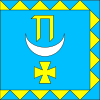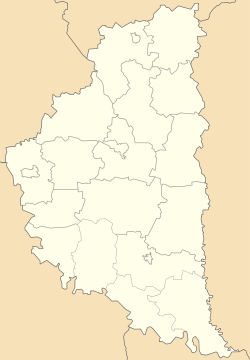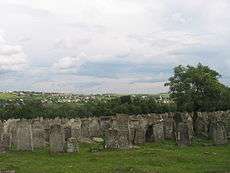Pidhaitsi
Pidhaitsi (Ukrainian: Підгайці, Pidhajci, Polish: Podhajce) is a small city in the Ternopil Oblast (province) of western Ukraine. It is the administrative center of the Pidhaitsi Raion (district), and is located ca. 15.5 mi south of Berezhany, 43.5 mi from Ternopil and ca. 62 mi south-east of Lviv. In 1939 Pidhaitsi obtained the formal status of a city.[1] During Soviet rule (1945–1991) it was part of the Berezhanskyi Raion. After Ukrainian independence, it was separated into an independent Pidhaitsi district.
Pidhaitsi Підгайці Podhajce | |
|---|---|
Main square of Pidhaitsi | |
 Flag  Coat of arms | |
 Pidhaitsi  Pidhaitsi | |
| Coordinates: 49°16′10″N 25°8′0″E | |
| Country | |
| Province | |
| District | Pidhaitsi Raion |
| First mentioned | 1463 |
| Magdeburg rights | 1539 |
| Population (2001) | |
| • Total | 3,300 |
| Time zone | UTC+2 (EET) |
| • Summer (DST) | UTC+3 (EEST) |
As of 2001 the estimated population was 3,300. Many of the current residents have the surname Koropetskyi/Koropetska, likely attributable to city's proximity to the Koropets River.
History
According to the sources, Pidhaitsi is one of the oldest settlements in the area. It was established in 1445.[1] The first written records of the town date to 1463, when a Catholic church was built by the regional governor, a member of the Potocki noble family. In 1698, the Battle of Podhajce took place near the town. Because of the Tatar invasions and its precarious location on Poland’s main route to the south, the city was surrounded by series of ramparts and rows with water. Most of the key monuments (churches, synagogue) were all built in impressive defensive style. In its early years, the town was governed according to Ruthenian and Polish law. In 1539 it was granted the right to use Magdeburg law. Here was fought the Battle of Podhajce (1667).
In modern period, Pidhaitsi was among the most important urban centers in western part of Podolia. Its population was almost entirely Jews and Poles. In 1897 an obelisk was erected adjacent to the (Polish) Catholic church to celebrate the 100th birthday of Polish writer Adam Mickiewicz. While the monument is still extant, the church is in desolate condition. In one of Pidhaitsi houses resided famous Polish composer Frédéric Chopin. After the Second World War, Pidhaitsi, along with most of eastern Galicia, was separated from Poland and annexed to the Ukrainian Soviet Socialist Republic in the Soviet Union. Since that time, the population has been almost entirely ethnically Ukrainian.
Jewish community

Prior to the Second World War, Pidhaitsi had a significant Jewish community. The population census of 1765 lists 1,370 Jews in the kahal district of Pidhaitsi and 1,079 Jews lived in Pidhaitsi itself. A century late town’s Jewish population significantly increased and numbered ca. 6,000 Jews in Pidhaitsi and 8,212 Jews in Pidhaitsi district (9.33% of whole population in the area). In the 20th century Pidahytsi's importance declined and the number of the Jews decreased to 2,827 according to the census of 1931. Pidhaitsi Synagogue (between 1621 and 1648), and the local Catholic parish church (1634) are the oldest buildings in the city.[2] The synagogue is closed and in ruined condition. In the post war years, the synagogue territory was turned into a market by the communists.
With the break of the Second World War there was a large influx of Jewish refugees from the west and the number of the Jews in the town at the time of Nazi annihilation was higher than 3,000. Pidhaitsi Judenrat was headed by Leibish Lilienfeld.[3] Due to the refugee and hygienic problems, in the winter of 1941–42 many of town Jews died of hunger and typhus epidemic. In 1942, on September 21 (Yom Kippur – Jewish most revered holiday, the day of atonement from sin) over 1,000 Jews were sent to the Belzec extermination camp and on October 30, 1,500 more Jews were deported to face death in Belzec extermination camp. Hundreds more were murdered in Pidhaitsi and its environs by Germans and Ukrainian police.[4]
The above memories of his experiences during the liquidation of the ghetto in Pidhaitsi has described by Genia Schwartz.[5]
| Year | Total Population | Jewish Population |
|---|---|---|
| 1880 | 5,943 | 4,012 |
| 1890 | 5,646 | 3,879 |
| 1900 | 5,790 | 3,557 |
| 1910 | 5,576 | 3,497 |
| 1910 | 5,576 | 3,497 |
| 1921 | 4,814 | 2,872 |
| 2016 | 3,300 | 0 |
Notable natives
- Ignacy Potocki, Polish count
- Tadeusz Łomnicki, Polish actor
- Jan Łomnicki, Polish film director and screenwriter
- Stanisław Rewera Potocki, Polish magnate and military leader
- Jerzy Choróbski, Polish neurosurgeon
- Leonard Rettel, Polish poet and writer
- Mikołaj Wolski, Polish military leader
- Arthur Murray, American dancer
- Abraham Weiss, professor of Talmud
References
- Official stats at the web-site of Verkhovna Rada (in Ukrainian)
- Sergey R. Kravtsov, "Gothic Survival in Synagogue Architecture of Ruthenia, Podolia and Volhynia in the 17th - 18th Centuries," Architectura. Zeitschrift für Geschichte der Baukunst/ Journal of the History of Architecture, vol. 1 (2005), 70-71.
- Nachum Pushteig: The Destruction of our City
- Megargee, Geoffrey (2012). Encyclopedia of Camps and Ghettos. Bloomington, Indiana: University of Indiana Press. p. 814.
- wiki.fizmat. Підгаєччина (in Ukrainian)
External links
| Wikimedia Commons has media related to Pidhaitsi, Ternopil Oblast. |
- (in English) Website about Pidhaitsi
- (in English) Photos of Pidhaitsi (70 digital images from 2004)
- (in English) Nature at Pidhaytsi — Photos
- (in English) Pidhaitsi Jewish history
- (in English) American Jewish couple visits Pidhaitsi (2001)
- (in English) Pidhaytsi Jewish history — article in word
- (in Ukrainian) Pidhaitsi info, history and photos